Phases of mitosis
Introduction
What do your intestines, the yeast in bread dough, and a developing frog all have in common? Among other things, they all have cells that carry out mitosis, dividing to produce more cells that are genetically identical to themselves.
Why do these very different organisms and tissues all need mitosis? Intestinal cells have to be replaced as they wear out; yeast cells need to reproduce to keep their population growing; and a tadpole must make new cells as it grows bigger and more complex.
What is mitosis?
Mitosis is a type of cell division in which one cell (the mother) divides to produce two new cells (the daughters) that are genetically identical to itself. In the context of the cell cycle, mitosis is the part of the division process in which the DNA of the cell's nucleus is split into two equal sets of chromosomes.
The great majority of the cell divisions that happen in your body involve mitosis. During development and growth, mitosis populates an organism’s body with cells, and throughout an organism’s life, it replaces old, worn-out cells with new ones. For single-celled eukaryotes like yeast, mitotic divisions are actually a form of reproduction, adding new individuals to the population.
In all of these cases, the “goal” of mitosis is to make sure that each daughter cell gets a perfect, full set of chromosomes. Cells with too few or too many chromosomes usually don’t function well: they may not survive, or they may even cause cancer. So, when cells undergo mitosis, they don’t just divide their DNA at random and toss it into piles for the two daughter cells. Instead, they split up their duplicated chromosomes in a carefully organized series of steps.
Phases of mitosis
Mitosis consists of four basic phases: prophase, metaphase, anaphase, and telophase. Some textbooks list five, breaking prophase into an early phase (called prophase) and a late phase (called prometaphase). These phases occur in strict sequential order, and cytokinesis - the process of dividing the cell contents to make two new cells - starts in anaphase or telophase.

Stages of mitosis: prophase, metaphase, anaphase, telophase. Cytokinesis typically overlaps with anaphase and/or telophase.
You can remember the order of the phases with the famous mnemonic: [Please] Pee on the MAT. But don’t get too hung up on names – what’s most important to understand is what’s happening at each stage, and why it’s important for the division of the chromosomes.
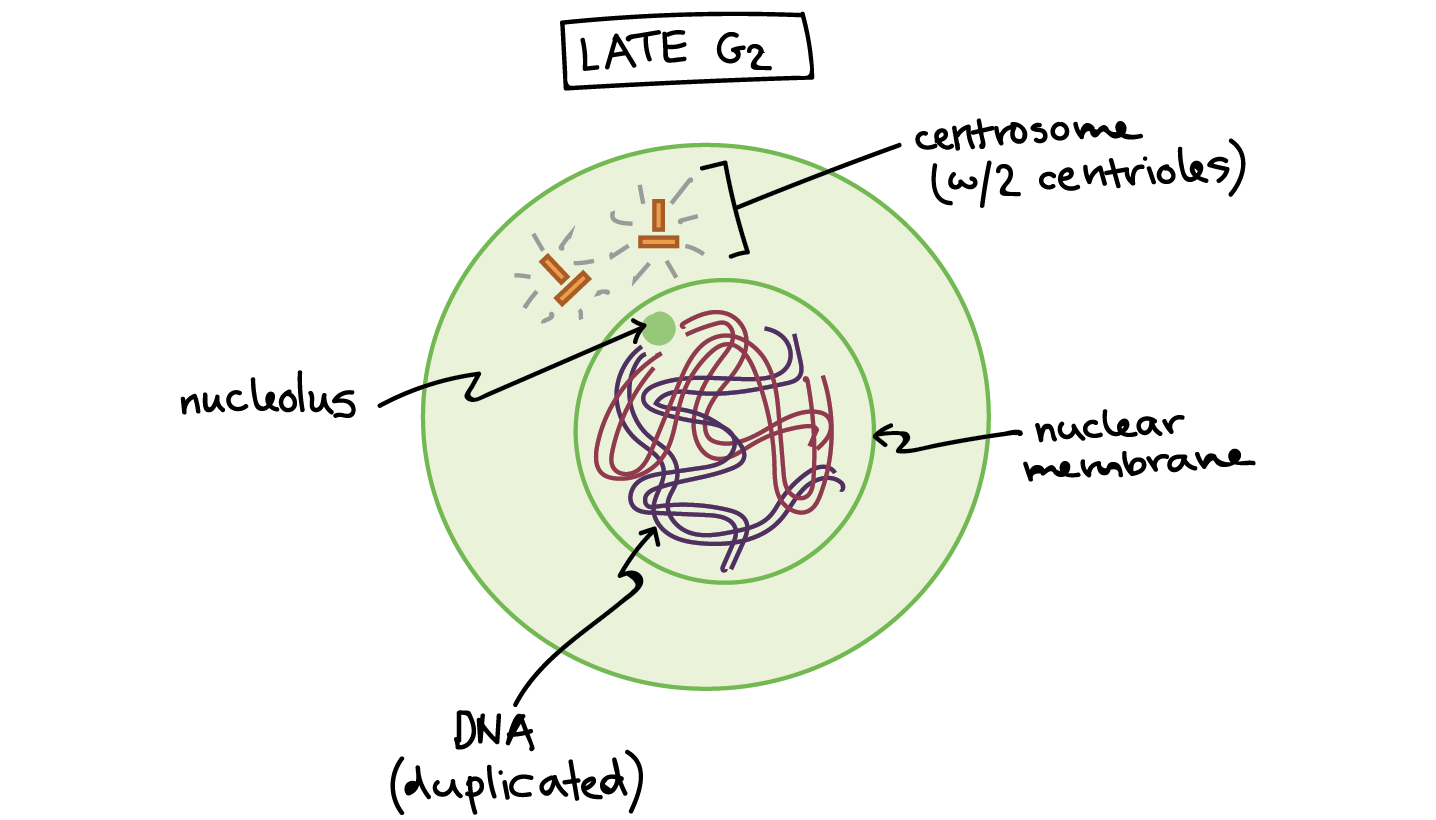
Late G2 phase. The cell has two centrosomes, each with two centrioles, and the DNA has been copied. At this stage, the DNA is surrounded by an intact nuclear membrane, and the nucleolus is present in the nucleus.
Let’s start by looking at a cell right before it begins mitosis. This cell is in interphase (late G2_22start subscript, 2, end subscript phase) and has already copied its DNA, so the chromosomes in the nucleus each consist of two connected copies, called sister chromatids. You can’t see the chromosomes very clearly at this point, because they are still in their long, stringy, decondensed form.
This animal cell has also made a copy of its centrosome, an organelle that will play a key role in orchestrating mitosis, so there are two centrosomes. (Plant cells generally don’t have centrosomes with centrioles, but have a different type of microtubule organizing center that plays a similar role.)
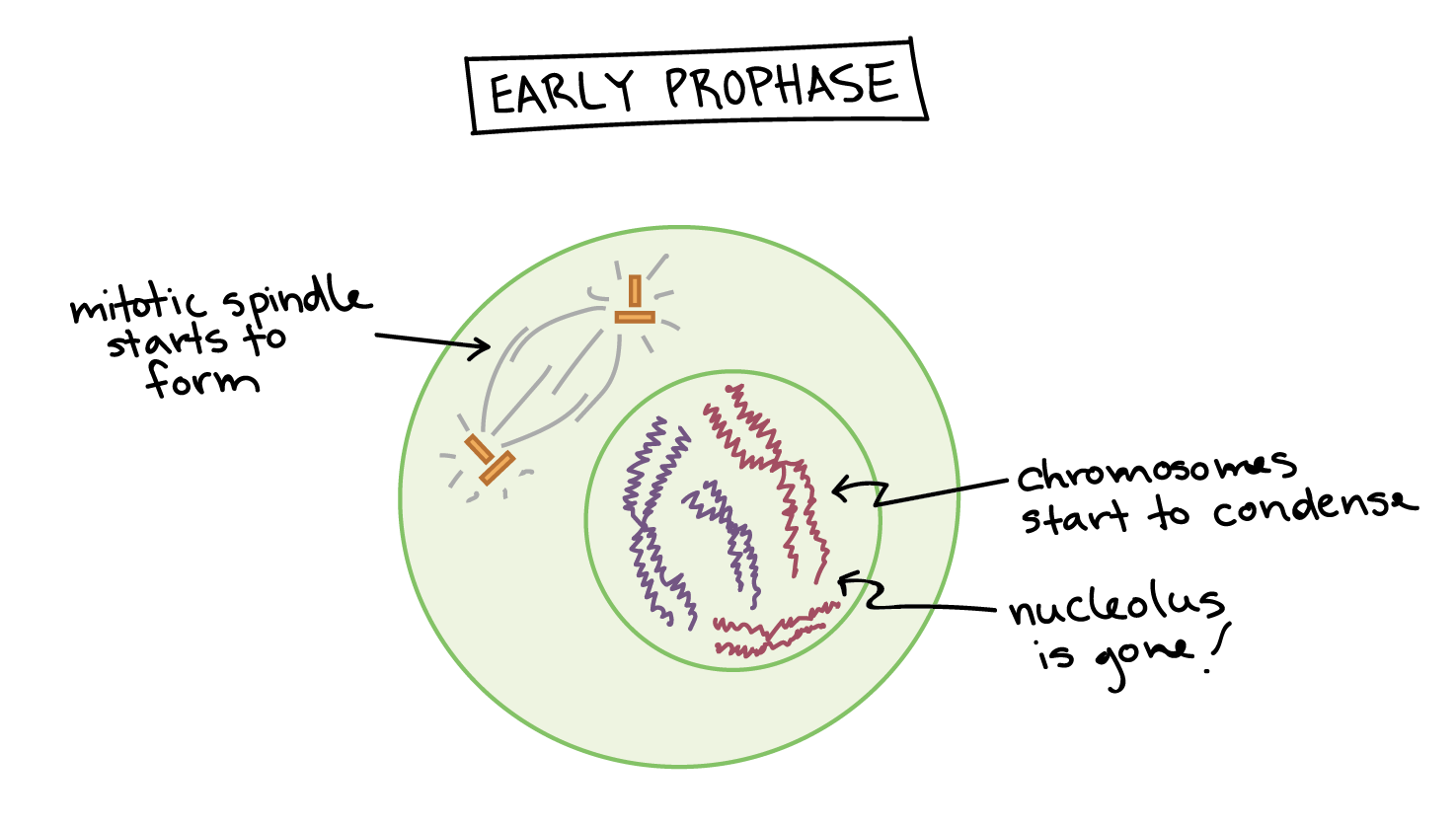
Early prophase. The mitotic spindle starts to form, the chromosomes start to condense, and the nucleolus disappears.
In early prophase, the cell starts to break down some structures and build others up, setting the stage for division of the chromosomes.
The chromosomes start to condense (making them easier to pull apart later on).
The mitotic spindle begins to form. The spindle is a structure made of microtubules, strong fibers that are part of the cell’s “skeleton.” Its job is to organize the chromosomes and move them around during mitosis. The spindle grows between the centrosomes as they move apart.
The nucleolus (or nucleoli, plural), a part of the nucleus where ribosomes are made, disappears. This is a sign that the nucleus is getting ready to break down.
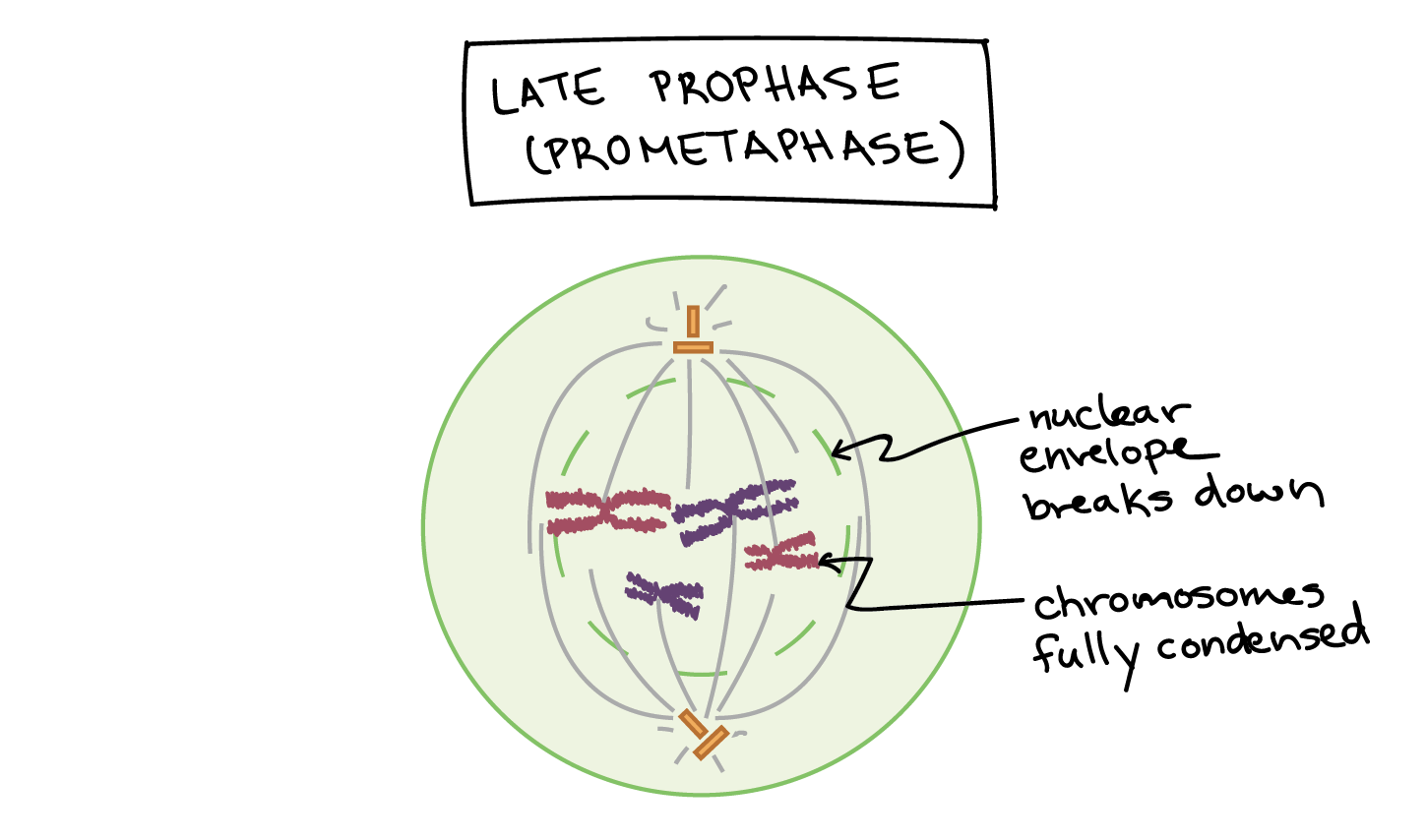
Late prophase (prometaphase). The nuclear envelope breaks down and the chromosomes are fully condensed.
In late prophase (sometimes also called prometaphase), the mitotic spindle begins to capture and organize the chromosomes.
The chromosomes become even more condensed, so they are very compact.
The nuclear envelope breaks down, releasing the chromosomes.
The mitotic spindle grows more, and some of the microtubules start to “capture” chromosomes.
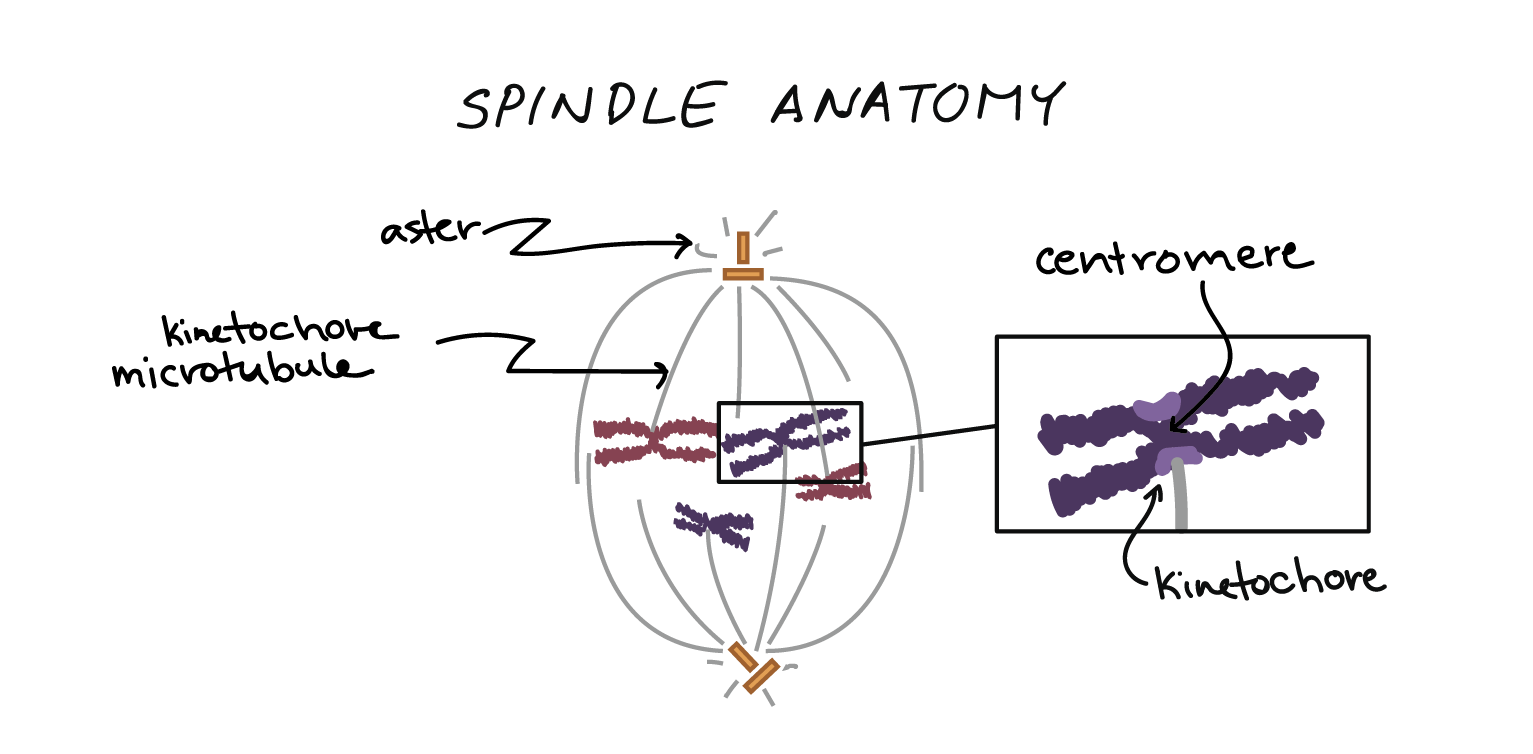
Anatomy of the mitotic spindle. Diagram indicating kinetochore microtubules (bound to kinetochores) and the aster. The aster is an array of microtubules that radiates out from the centrosome towards the cell edge. Diagram also indicates the centromere region of a chromosome, the narrow "waist" where the two sister chromatids are most tightly connected, and the kinetochore, a pad of proteins found at the centromere.
Microtubules can bind to chromosomes at the kinetochore, a patch of protein found on the centromere of each sister chromatid. (Centromeres are the regions of DNA where the sister chromatids are most tightly connected.)
Microtubules that bind a chromosome are called kinetochore microtubules. Microtubules that don’t bind to kinetochores can grab on to microtubules from the opposite pole, stabilizing the spindle. More microtubules extend from each centrosome towards the edge of the cell, forming a structure called the aster.
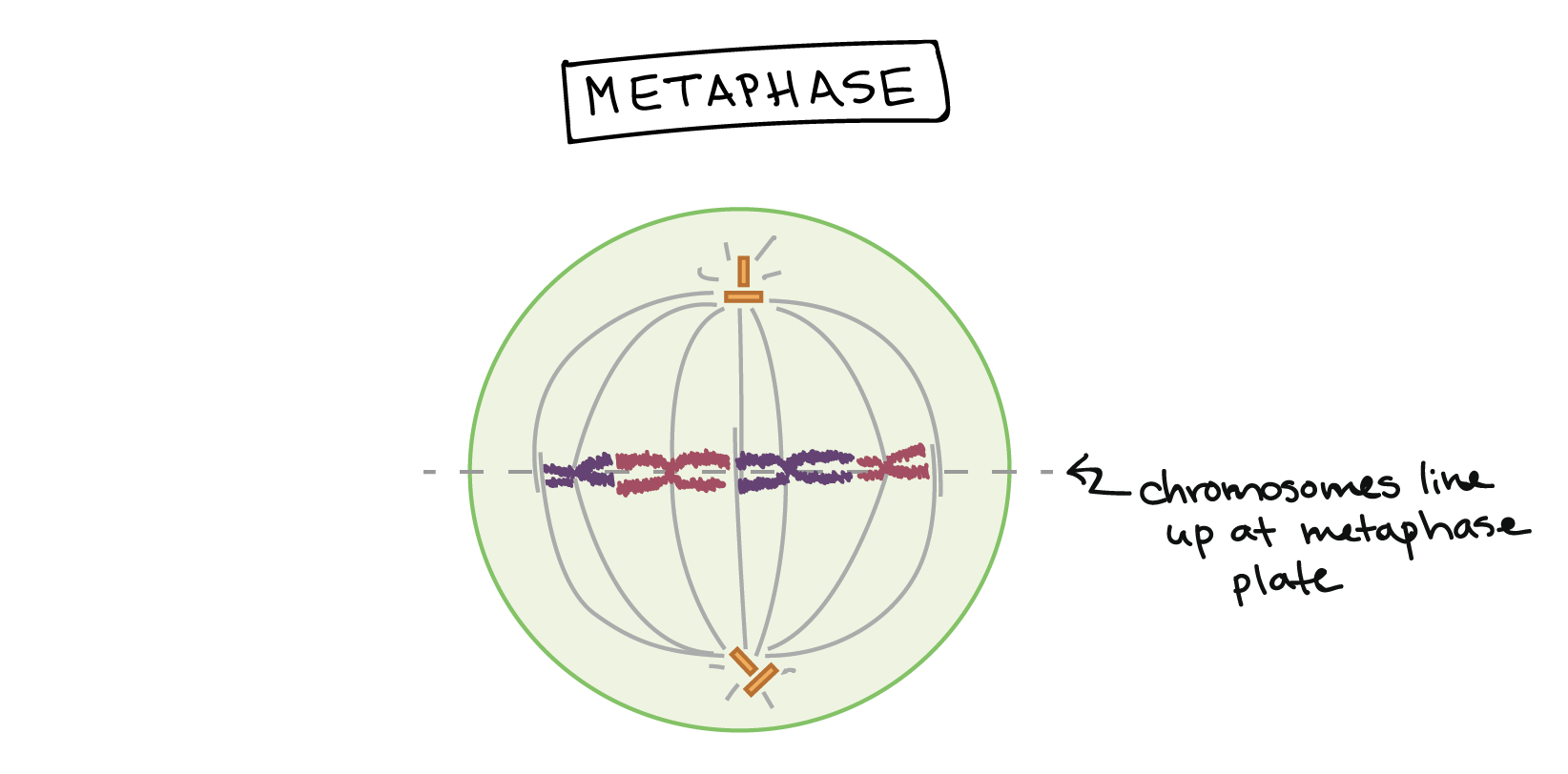
Metaphase. Chromosomes line up at the metaphase plate, under tension from the mitotic spindle. The two sister chromatids of each chromosome are captured by microtubules from opposite spindle poles.
In metaphase, the spindle has captured all the chromosomes and lined them up at the middle of the cell, ready to divide.
All the chromosomes align at the metaphase plate (not a physical structure, just a term for the plane where the chromosomes line up).
At this stage, the two kinetochores of each chromosome should be attached to microtubules from opposite spindle poles.
Before proceeding to anaphase, the cell will check to make sure that all the chromosomes are at the metaphase plate with their kinetochores correctly attached to microtubules. This is called the spindle checkpoint and helps ensure that the sister chromatids will split evenly between the two daughter cells when they separate in the next step. If a chromosome is not properly aligned or attached, the cell will halt division until the problem is fixed.
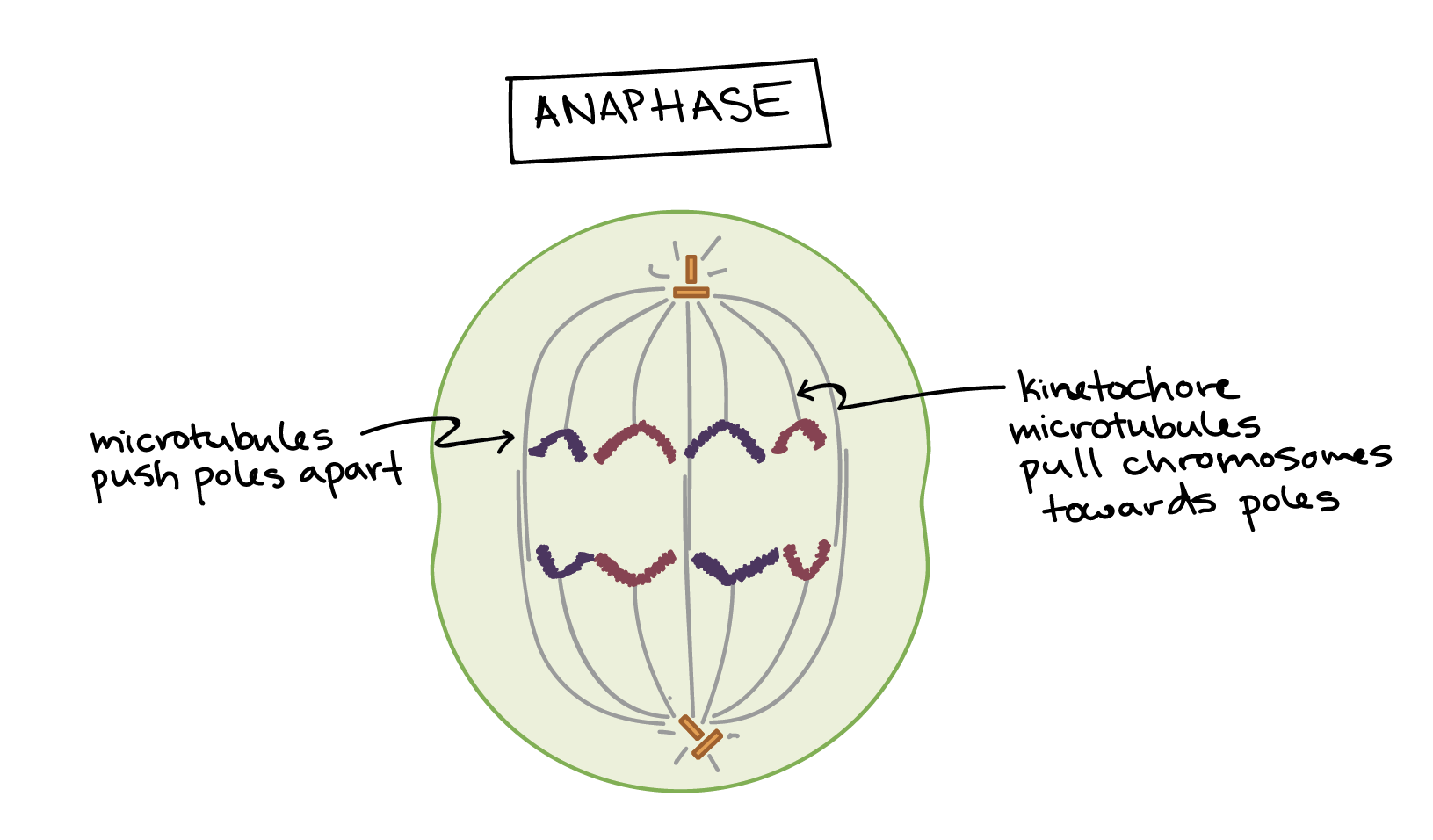
Anaphase. The sister chromatids separate from one another and are pulled towards opposite poles of the cell. The microtubules that are not attached to chromosomes push the two poles of the spindle apart, while the kinetochore microtubules pull the chromosomes towards the poles.
In anaphase, the sister chromatids separate from each other and are pulled towards opposite ends of the cell.
The protein “glue” that holds the sister chromatids together is broken down, allowing them to separate. Each is now its own chromosome. The chromosomes of each pair are pulled towards opposite ends of the cell.
Microtubules not attached to chromosomes elongate and push apart, separating the poles and making the cell longer.
All of these processes are driven by motor proteins, molecular machines that can “walk” along microtubule tracks and carry a cargo. In mitosis, motor proteins carry chromosomes or other microtubules as they walk.
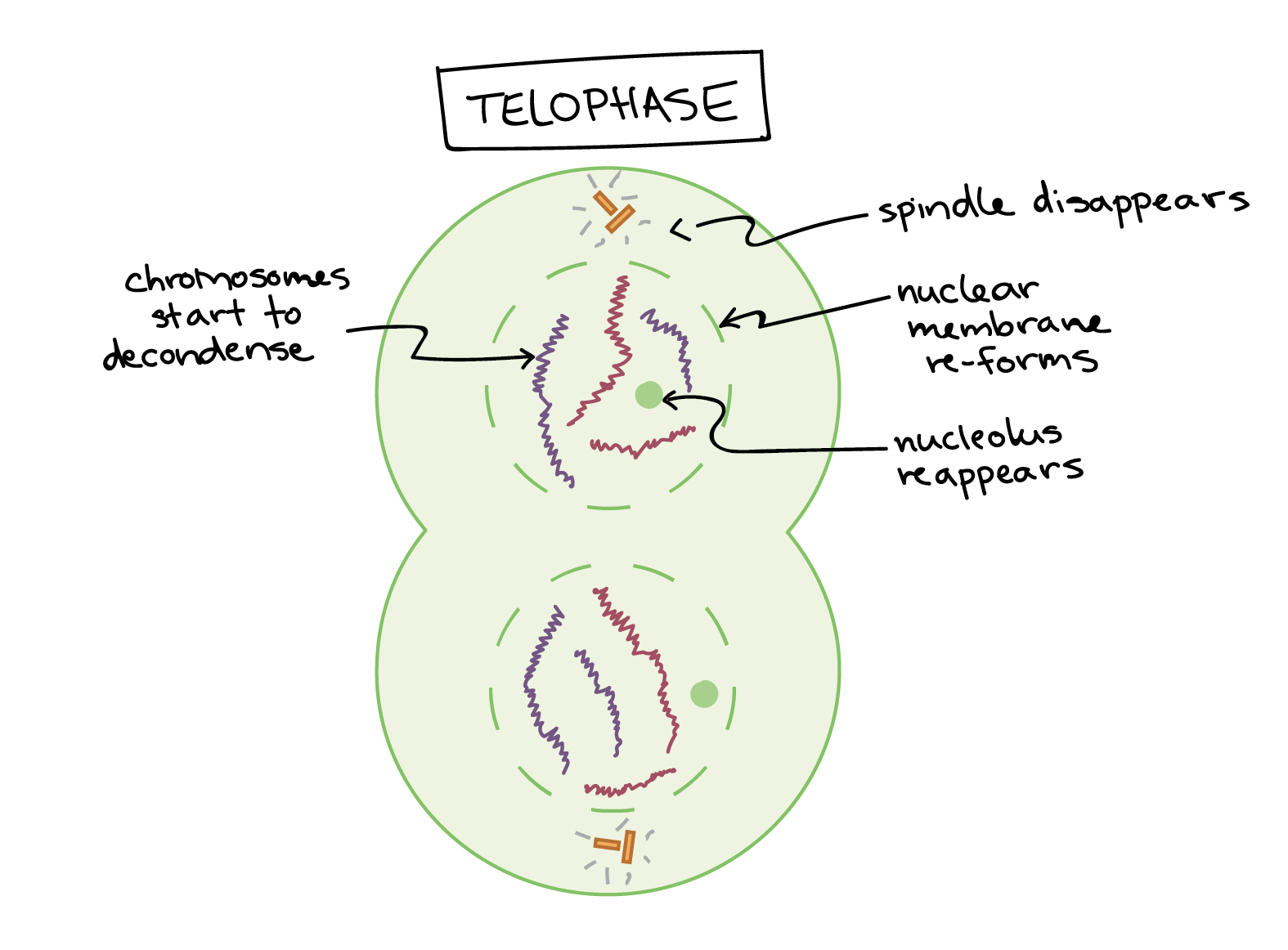
Telophase. The spindle disappears, a nuclear membrane re-forms around each set of chromosomes, and a nucleolus reappears in each new nucleus. The chromosomes also start to decondense.
In telophase, the cell is nearly done dividing, and it starts to re-establish its normal structures as cytokinesis (division of the cell contents) takes place.
The mitotic spindle is broken down into its building blocks.
Two new nuclei form, one for each set of chromosomes. Nuclear membranes and nucleoli reappear.
The chromosomes begin to decondense and return to their “stringy” form.
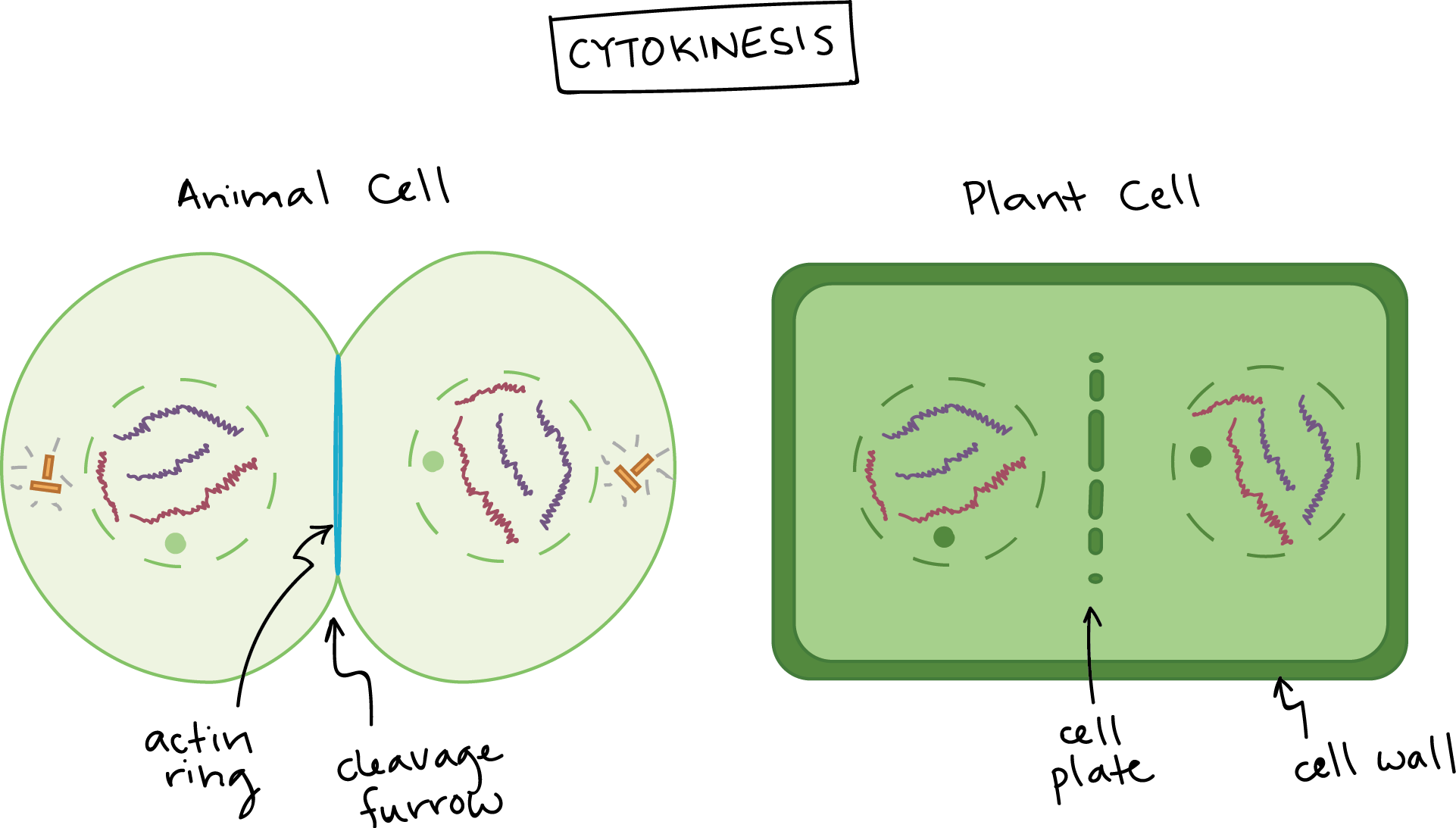
Cytokinesis in animal and plant cells.
Cytokinesis in an animal cell: an actin ring around the middle of the cell pinches inward, creating an indentation called the cleavage furrow.
Cytokinesis in a plant cell: the cell plate forms down the middle of the cell, creating a new wall that partitions it in two.
Cytokinesis, the division of the cytoplasm to form two new cells, overlaps with the final stages of mitosis. It may start in either anaphase or telophase, depending on the cell, and finishes shortly after telophase.
In animal cells, cytokinesis is contractile, pinching the cell in two like a coin purse with a drawstring. The “drawstring” is a band of filaments made of a protein called actin, and the pinch crease is known as the cleavage furrow. Plant cells can’t be divided like this because they have a cell wall and are too stiff. Instead, a structure called the cell plate forms down the middle of the cell, splitting it into two daughter cells separated by a new wall. 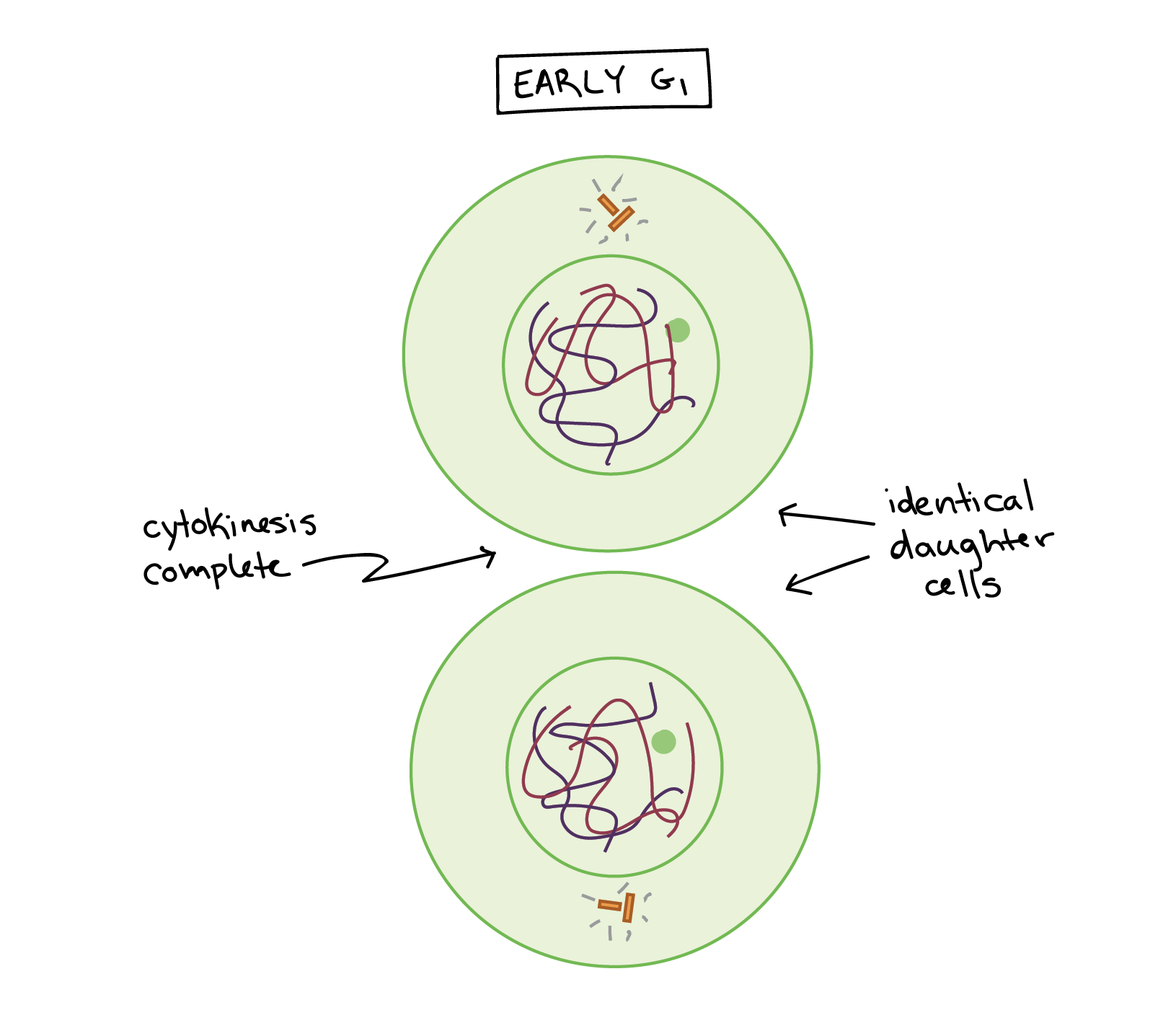 When division is complete, it produces two daughter cells. Each daughter cell has a complete set of chromosomes, identical to that of its sister (and that of the mother cell). The daughter cells enter the cell cycle in G1.
When division is complete, it produces two daughter cells. Each daughter cell has a complete set of chromosomes, identical to that of its sister (and that of the mother cell). The daughter cells enter the cell cycle in G1.
When cytokinesis finishes, we end up with two new cells, each with a complete set of chromosomes identical to those of the mother cell. The daughter cells can now begin their own cellular “lives,” and – depending on what they decide to be when they grow up – may undergo mitosis themselves, repeating the cycle.
 Knowt
Knowt
